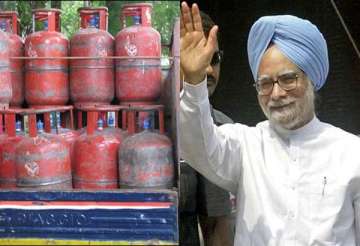Govt May Hike LPG Cylinder Price To Rs 800
New Delhi, Jul 9: If the oil ministry has its way, cooking gas consumers would soon get only four refills in a year at subsidized rate. Every subsequent cylinder would cost Rs 800 or so
New Delhi, Jul 9: If the oil ministry has its way, cooking gas consumers would soon get only four refills in a year at subsidized rate. Every subsequent cylinder would cost Rs 800 or so at today's market price, says a media report.
The ministry proposes to limit the number of subsidized cylinders for even BPL (below poverty line) at four cylinders a year. But the government would give them a one-time assistance of Rs 1,400 for getting a connection.
A formal proposal, being drawn up by the ministry for the ministerial panel on fuels, explains that the plan would ensure that government subsidy reaches only those who deserve it and stop the huge black market in subsidized kerosene supplied for the poor.
The proposal outlines the criteria to identify those who have to pay market price for refills. These include anyone who owns a car, two-wheeler, house or figures in the income-tax list. The subsidy to BPL cardholders would be delivered through the unique identification number, Aadhar, as it is commonly known, regime that is in the works.
The proposal rationalizes the move on the ground the present system does not differentiate between the needy and those who can afford to pay market price. It says even billionaires get their fuel at subsidized rate in the present system.
The ministry reckons four cylinders would be enough to take care of the cooking needs of a BPL family. The ministry's view is based on studies that indicate that most of the kerosene consumed by BPL families is used for lighting purpose and wood or cow dung cakes remain the choice of fuels for cooking.
The Centre at present supplies 9-10 million tonnes of subsidized kerosene a year for selling to poor through ration shops controlled by state governments. Several government and independent studies have said nearly 40% of the fuel is diverted for adulteration of motor fuels, giving rise to a black market worth over Rs 16,000 crore at today's market price.
Consumers now pay an average of Rs 400 for a cylinder because of a subsidy of Rs 395. The government had last month raised LPG price by Rs 50 a cylinder, kerosene by Rs 2 per litre and reduced oil taxes. Still, together with diesel, it expects a subsidy bill of Rs 120,000 crore in 2011-12.
The proposal says the new plan would reduce the government's subsidy burden on cooking gas, estimated at Rs 12,000 crore as per the price prevailing in 2009-10. This would be much higher according to 2010-11 price line.
There are, however, some grey areas that may delay the plan. The Planning Commission, for one, during inter-government discussions has opposed the ministry's cap on the number of subsidized cylinders. The government's policy think-tank says six cylinders a year is the average national consumption pattern and the ministry should not go below this.
The ministry itself is grappling with the issue of administering the rollout of cooking gas connections among BPL families as replacement of the system of earmarking certain quantities of kerosene to states (kerosene quota). This is because kerosene for poor is driven by supply, while cooking gas is purely driven by demand.
The states too are likely to oppose the move since it would reduce their kerosene quota. The fuel is one of the mainstays of the ration shops that are one of the major ways the ruling dispensation takes care of their cadres.
